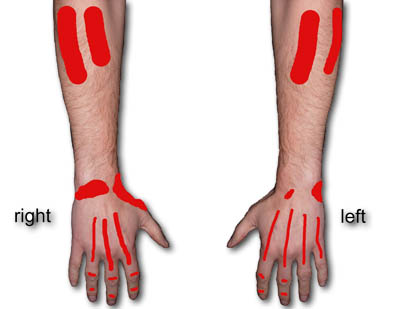 Below, I provide a list of criteria that I would associate with a worker who will have an elevated risk of contracting an RSI condition. If you associate with a few of these activities, then you too may be at high risk of developing a RSI condition –
Below, I provide a list of criteria that I would associate with a worker who will have an elevated risk of contracting an RSI condition. If you associate with a few of these activities, then you too may be at high risk of developing a RSI condition –
- Computer operator professional or otherwise
- Deep in concentration about your work, intolerant of interruptions
- You slouch at your desk, peering at the computer screen, unaware of your posture
- Working on a key project with tight deadline
- Stressing about achieving that deadline
- Working in a competitive environment in uncertain times
- Spending your work time at a computer for 5-10 hours a day
- Taking minimal breaks, and most of these are spent checking email /surfing the web
- Lunch is frequently a sandwich eaten at your desk whilst working
- You are a heavy coffee drinker
- You spend a cumulative 30 min/day sending text messages on your mobile phone
- You go home after a 10 hour day and relax by ripping some CDs to mp3, updating your iPod, catching up on personal email and unwinding by playing a ‘shoot ’em up’ on your computer/games system for 2-3 hours
- You spends 6-8 hours sleeping before starting the cycle again
Lets break down each point and try to inject some solutions –
 The common position for hands hovering above a keyboard is as shown on the right, which I refer to as the ‘claw’. This position elevates the tension in the aforementioned extensor muscles, causing them to become fatigued over prolonged periods of time. Typing whilst the hand/wrists are in this position (another common posture mistake) will further
The common position for hands hovering above a keyboard is as shown on the right, which I refer to as the ‘claw’. This position elevates the tension in the aforementioned extensor muscles, causing them to become fatigued over prolonged periods of time. Typing whilst the hand/wrists are in this position (another common posture mistake) will further 
 During the course of my injury, I have frequently encountered opinions and references to RSI injuries being “all in the mind” (a reference to the sufferer somehow psychologically inducing RSI pain rather than there being an actual physical cause).
During the course of my injury, I have frequently encountered opinions and references to RSI injuries being “all in the mind” (a reference to the sufferer somehow psychologically inducing RSI pain rather than there being an actual physical cause). The rate of success in dealing with RSI symptoms is proportional to the speed that a sufferer can diagnose the causes of those symptoms, and their understanding of the corrective actions required to avoid further injury.
The rate of success in dealing with RSI symptoms is proportional to the speed that a sufferer can diagnose the causes of those symptoms, and their understanding of the corrective actions required to avoid further injury.